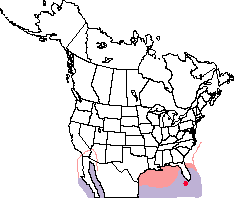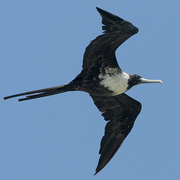Magnificent Frigatebird
Fregata
magnificens
Pelecaniformes
These birds are aquatic, medium-sized to large, and feed on small fish and other animals found in the water. One of their most distinctive features is their feet, which have webbing between all four toes. Many have an unfeathered and sometimes brightly colored pouch of varying size at the throat. Most nest in colonies. Representatives of five of the order's six families have been found in Washington:
Fregatidae
Frigatebirds are large, lightweight birds. All five species in this family are mostly black, with long, pointed wings and tails and long, hooked bills. They are exceptional gliders and can hang in the air for hours without flapping their wings. Because they cannot take off from the water, they do not swim, but they will dip down to the water's surface and grab food, or steal food from other birds. They typically eat flying fish, squid, jellyfish, and other sea creatures at the water's surface. They are not migratory but may wander widely, and generally land on islands or shoreline trees to rest. They are colonial nesters, and males display by inflating large throat pouches. Frigatebirds are one of few seabirds that are sexually dimorphic: females generally have more white on their mostly-black plumage, and are about 24 percent larger than males. Females build nests with materials gathered by males, and both sexes help incubate and feed a single chick. Frigatebirds are long-lived birds with prolonged nesting cycles. Young can be dependent on the adults for up to two years, and do not begin to nest until they are between five and 11 years old. Once they begin breeding, they nest once every one to four years.
General Description
The first state record is from the interior, at Umatilla NWR in July 1975. A second bird was seen at several Westside locations (Puget Sound, South Coast, mouth of Columbia River) for much of October 1988.
North American Range Map




